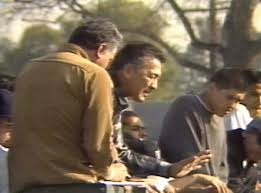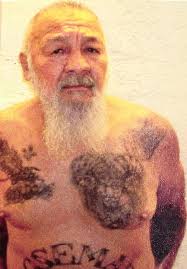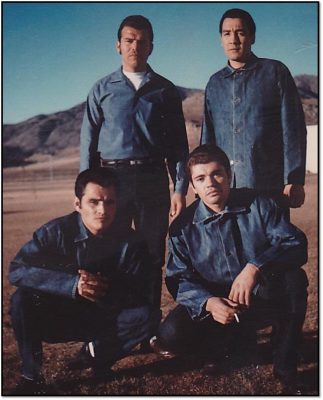Los Angeles never had a mafia in the way that many East Coast cities did.
Regional organized crime never really took root out here. So we never had the mafia dons, running the large crime syndicates that made the headlines in, say, Cleveland or New York.
About as close as we came was Peter “Sana” Ojeda.
Ojeda, the oldest active member of the Mexican Mafia, died June 7, according to the federal Bureau of Prisons website, which lists him as 76 years old.
Sources tell me he apparently suffered a heart attack during an operation in a federal prison medical facility. YouTube memorials are already up.
To understand Ojeda’s importance, it’s important also to understand that the Mexican Mafia is neither Mexican nor was it, for many years, a mafia, strictly speaking. It is a prison gang, controlling Latino gang members in the state prison system. It took its name as a way of inspiring fear in others. Ojeda was part of that formation early on, as well as the spread of the Mafia’s influence across the state prison system.
The Mexican Mafia had no connection (until recent years) to the underworld in Mexico. Its members were, to begin with and for many years, like Ojeda’s, Mexican-American, who spoke only halting Spanish, if any at all, and whose families had been in the United States for generations.
For many years, in fact, the Mexican Mafia only ran prison yards and its influence was barely felt outside those walls.
But in the early 1990s, all that changed. The man who ushered in that change was Peter “Sana” Ojeda, a long-time member of the Mexican Mafia who had grown up in Orange County.
Ojeda, who was then on the streets, organized a meeting of O.C. street gangs at El Salvador Park in Santa Ana, filmed by law enforcement, during which he stood on bleachers dressed in a black-and-white long-sleeve shirt and told them all to stop with the gang killings and the drive-by shootings. He urged them to tax drug dealers in their neighborhoods as a way of funding neighborhood defense.
This stunned many in the Mexican Mafia, and they began to follow his lead, often using emissaries to organize meetings from San Bernardino and Pomona out to Elysian Park in Los Angeles, where one of the biggest meetings was held.
The Peace Treaty, as all this came to be known, sounded great. Gang leaders doing what law enforcement could not. But it evolved into something sinister and lasting: A system whereby gang members would indeed tax drug dealers in their area and funnel the proceeds to Mafia members, many of whom were in prison for life.
This taxation system far outlasted the Peace Treaty and is still in place today across Southern California, described in dozens of federal RICO indictments and in interviews I’ve done with dozens of gang members.
It amounts to the only regional organized crime syndicate that Southern California has ever known.
Taxation transformed Latino street gangs from scruffy neighborhood territorial entities into money-making ventures, though these were often fairly rag-tag. It gave career criminals, doing life terms in prison, access to a labor force — youths on the street who would do their bidding and admired them the way little leaguers look up to major league ball players. The Big Homies, as they were known on the street, could change life in a barrio with only a few words smuggled from prison in microprint on small pieces of paper.
It’s worth noting that their organizations on the streets, too, were often inept, bumbling, hampered by limited communications, by greed, envy, betrayal, rumor and gossip and drug use, as well as the constant return to prison of anointed emissaries of incarcerated Mafia members. One trial I sat in on involved a mafia member trying to organize three gang members to kill a rival, a man who rarely drove but was often walking in his Pomona neighborhood. Dozens and dozens of cellphone calls on how to do this and it still didn’t happen.
But Mafia taxation changed a lot about Southern California street life.
For a decade, Latino street gangs became the leading race-hate criminals in Southern California, a culture that grew from orders by many members of the Mexican Mafia that gangs should now rid their areas of black street gang/drug sales competition. As they were interpreted on the street, far from direct Mafia control, those orders often became directed at any black person, and thus in some neighborhoods campaigns were waged to get all black families to leave, which included murder, firebombings, assaults, racist graffiti and more.
Taxation made Mexican Mafia members equal in many communities to the town mayor or city council, at least with when it came to their ability to affect life in those areas. Now with the obedience of thousands of gang members on the street, many of whom were too young to have ever laid eyes on the incarcerated men they were obeying, Mafia members  could, and did, ignite crime waves from maximum-security cells merely through letters smuggled from prison or via liaisons who transmitted their orders to the street. They drained city budgets, mangled lives, and forced young gang members to commit crimes that landed them in prison for life. I’ve interviewed several young men in such situations.
could, and did, ignite crime waves from maximum-security cells merely through letters smuggled from prison or via liaisons who transmitted their orders to the street. They drained city budgets, mangled lives, and forced young gang members to commit crimes that landed them in prison for life. I’ve interviewed several young men in such situations.
Ojeda was a contemporary of the pioneers of the Mexican Mafia (he’s far lower left in this photo). Among them was Joe Morgan (standing above him in the photo), whose story is also fascinating. Morgan was a Serbian-American who grew up in Boyle Heights/East LA and became culturally Mexican-American, and helped found the Mexican Mafia. Morgan died many years ago.
Ojeda was the last surviving member of that generation of the Mexican Mafia, made a member in 1972 in Tehachapi. Here’s a photo of him from those years (top right).
Throughout his life, but especially following the Salvador Park meeting, he would remain a household name in the Southern California Latino street-gang world. Meanwhile, he was in and out of prison.
In 2016, he was convicted a final time of conspiracy, largely on the basis of testimony from a former protégé, and sent to prison for 15 years, which most people figured was a life sentence.
But his control over Santa Ana and much of Orange County Latino street gang life seemed to me mostly unquestioned. So, too, his reputation as the Godfather of Orange County.




The Italian Mafia is dead now the eme is alive and kicking
Hopefully your not trying to glorify these cats who use and take advantage of their own youngsters AND when they walked the line, there were not a million cameras and the DA’s were not picking up every stabbing,introducing narcotic’s,ect ect…they just had to go to the hole where they banged dope all day making everyone show off to other races how long their work out routines were..Giving orders to stab who ever they wanted to dudes not doing life already and envy ,jealous , friendamies,hate each other and all think they’re smarter than the next member and too many chiefs that all want heroine and money..that’s it,that’s all
Anybody have any info on a Maifioso “Tripas” from Gilroy. I was on the “grey goose” from Quilmas to Chino,Tripas and a couple of his pals were on the same chain in the 70’s. Haven’t heard anything about the vato who is supposed to be a “straight killer”. Appreciate any info. CON SAFOS
The la family also had a working crew for many years in Vegas, Palm Springs up to the 2010s. Also a crew in riverside/ San Bernardino county . They had a made guy inside one of the Indian casinos .. for a small borgata/ family they had stuff going all the way to San diego
Sam does an excellent job of reporting but eMe isn’t nearly as impactful as the Dippolitos, Desimones and others. So long as la eMe is run from the inside out and drug dependency remains high among the “shotcallers” they will never move beyond exploitation of their own neighborhoods. It’s in the interest of the Gang Investigators to perpetuate stories of a monolithic statewide organization of loyal and fearless gladiators. The truth is loyalty and honor is virtually non-existent and the little power and influence one member exert over others is subject to change without warning.
I would argue that in the early 1930’s, Jack Dragna and his mob certainly did have a similar control of all of southern California to what the Mexican Mafia enjoyed since the later 20th century. Once Bugsy Siegel moved out west in the late 1930s, and Dragna was given direct orders by Lucky Luciano to stay out of Siegel’s way, LA had become essentially an open city for NY and Chicago mobsters to plunder at will. As the mob’s influence waned in the late 20th century, minority gangs, like la Eme, began to control crime in southern California.
Hi Sam,
How do I contact you about a different story that needs to be told?
My email is samquinones7@yahoo.com
So Cuccia, Andrizzone, Dragna & Co. never existed then. Oh come on now…
The FBI listed the “LA family” as a viable, recognized and highly active outfit until the early ‘90s. It was composed mostly of transplants from out East (specifically Buffalo and NYC of course) as well as Midwesterner from Chicago, Detroit and Cleveland. The Cherry Hills, NJ, Sicilians had many interests in So Cal up until recently (early 2000’s).
Plenty of activities that did not overlap the interests of local gangs and outfits. We’re they small time compared to NY? Yes, but not to be disregarded as a mere crew. The history of traditional organized crime in Southern California has been widely researched. Time to catch up Sam.
I guess this reporter never heard of jack dragna boss of the la family of the Italian Mafia in the late 30s to the 50s!! His cousin was tommy lucchese of the New York lucchese family!
I think the point I was trying to make is that never in the history of Southern California have we had a regional organized crime syndicate. Unless you’re arguing that Jack Dragna operated in San Diego, National City, Chula Vista, Santa Ana, Anaheim, Pomona, Ontario, Pasadena, Riverside, San Bernardino, Fontana, Rialto, Cucamonga, Redlands, Azusa, West Covina, Paramount, South Gate, Huntington Park, Downey, Bell, Bell Gardens, Cudahy, Maywood, Commerce, Whittier, Compton, Long Beach, Florence-Firestone, Willowbrook, East LA, Inglewood, Hawaiian Gardens, Carson, Oxnard, Santa Paula, and many more I’m forgetting….and of course dozens of neighborhoods across the city of Los Angeles: Cypress Park, Highland Park, Glassell Park, South-Central, Mid-City, Pico-Union, Pacoima, Van Nuys, Harbor Gateway, Boyle Heights, and on and on. the Mexican Mafia taxation system is, or has been, in all those places.
Does anyone really have to “argue” that a crime family operated in more than ONE neighborhood? Of course they did. They had people scattered all around the city/county. They weren’t called the “Downtown LA” family nor the “Burbank” family. They taxed so-called “gypsies” (non-family affiliated bookies and loan-sharks). Also, there have been plenty of cases involving taxation of non-mobbed up activities (specifically clubs and porn production companies). San Diego was overseen by Frank Bompensiero, for instance.
The la family of Cosa Nostra had a made member from Ventura ca right next to Oxnard!, on another note al Capone ran drugs from tj trouble Oxnard to Chicago !! That’s a fact too!!
There was also a crew headed by a capo who later became boss years after jack dragna’s death in the oc I forgot what city, they also had a crew in Palm Springs for many yrs till maybe the 2010’s ! And they also had a working crew in Las Vegas
Pingback: Death of a Godfather: Peter ‘Sana’ Ojeda Reshaped the Mexican Mafia and Paved the Way for SoCal's Gentrification ~ L.A. TACO
Who ever wrote this article dont know what they are talking about.first of all there was an italian mafia family in san pedro, ca.the ruggeiro brothers. Also the former owner of de carlo’s bakery was involved, and they found him floating in the san pedro harbor.
There was never a regional organized crime syndicate in Southern California of the kind that existed in many East Coast cities, local exceptions here and there notwithstanding.The Mexican Mafia’s taxation system was as close as we’ve ever come to that.